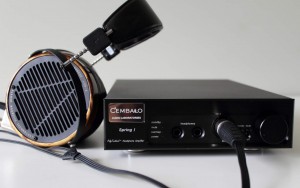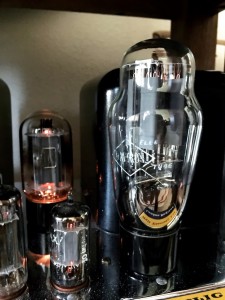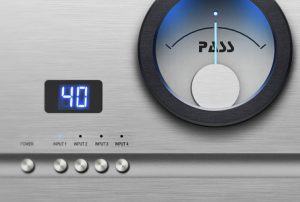Defying Expectations
For some time now, I have hinted that the Bryston Limited 4B³ Stereo Power Amplifier (pronounced "Four Bee Cubed") is not your father's Bryston (to wit, neutral, quiet, and highly linear, but also somewhat lacking in air, instrumental body and overall transparency). In my 2016 AXPONA show report, I described the updated Bryston house sound as dynamically robust but also (surprisingly to many) open and airy. A good bit of the credit for this sweet yet open sound went to the new Bryston 7B³ mono amps on display. With the amps doing their thing, I heard a strikingly transparent presentation that delivered incredible upper octave sweetness and an overall naturalness that caught me off-guard. I liked the sound of the amps (and the system overall) enough that I requested a review sample of the 4B³, a smaller package that proved quite easy to install in my small listening room.
In my recent review of Magneplanar's exquisite little 1.7i planar loudspeakers (Issue 86), replacing my long-standing reference Cambridge 840W power amp with the Bryston 4B³ resulted in wholesale sound quality improvements that were neither subtle nor limited to a narrow frequency band. From the top of its range down to about 45 cycles, the 1.7 is consistently sounded (and sound) more dynamic, composed, tonally fluid, and lifelike when driven by the 4B³.
To anyone who has followed the Ontario-based firm's upward sonic trajectory over the past five or six years, the outstanding performance the 4B³ delivers will not come as a big surprise (although I'm willing to bet that even longtime Bryston fans will be a bit surprised at just how good the new amp actually does sound). Whether in the digital domain (where their digital players and DACs have garnered near-universal acclaim), or the solid state amplifier universe (not to mention a relatively new line of high performance speakers), I think it's safe to say that the boys and girls from Peterborough have, performance-wise, taken the company to new sonic heights.
And yet, at least as far back as 2009, the writing had already started to appear on the wall. You see, in 2009 none other than the late Harry Pearson published a glowing review in that other magazine wherein he admitted to conflating the sound of Bryston's mighty 28B mono blocks with that of a great Audio Research tube amp at an audio show, that is, until he learned that the sound that impressed him so came from a solid state amplifier, one designed by a firm best known for its work in the world of professional audio. HP wasn't the only scribe to notice and hear that in overall sound quality terms, things had changed for the better at casa Bryston. Reviewer after reviewer came to the same conclusions: the circuit design and power supply improvements incorporated in the 28B mono blocks (now 28B³) produced a wholesale improvement in the Bryston sound.
Over time, these advances trickled down to the firm's lower-priced models, leading to further accolades. But the Peterborough team didn't stop with the advances deployed throughout the SST2 line of products. Over the past several years, a dedicated team of designers and engineers—led by the talented Christopher Russell—labored to identify new ways to improve the sound of the company's unabashedly solid state power amps. Enter the late physicist and engineer Dr. Ioan Alexandru Salomie, who, along with the Russell-led team, devised "a new patented input circuit that is precisely optimized and linear beyond any (the firm has) used before. Featuring twelve active devices in a groundbreaking array, this new circuit both matches the amplifier to virtually any preamplifier and provides the first 6dB of gain."
The company claims that the new input stage delivers superb overall transparency with measurable distortion levels of less than 1/1000th of 1 percent. Bryston also claims that the newly designed Cubed Series circuitry renders the amps virtually impervious to noise such as RFI and others induced by external and environmental sources. Each amplifier channel includes its own fully independent power supply with separate beefy transformer.
The new Cubed series amps also feature updated front panel cosmetics. The most prominent features include sculpted depressions running lengthwise that give the unit a softer countenance, and a recessed, centrally placed square insert with rounded corners adorned with the Bryston name engraved at the top of the square, and the amp model number engraved just below. I very much like the new front panel look but a brief scan of online blogs suggests that the new adornments do have detractors. My review sample (weighing in at a little over 60 lbs.) came with a lovely bead-blasted silver front panel (roughly ½ inch thick) and securely affixed front panel rack handles. The overall look strikes me as organic and sophisticated.
Round back, RCA and XLR inputs reside on each side of the amp, along with clear plastic speaker connectors that provide just about the securest spade contacts I've ever encountered. Simply unscrew the binding posts to the desired depth (my reference Silnote Audio Orion M2 speaker cable spades are pretty thick), insert the spades securely into the conveniently placed precut channels and re-tighten the terminals. Be sure to set the input gain toggle switches at 23dB when using balanced interconnects, as I did, or 29dB when running the amp in single-ended mode. Last but not least, I substituted Bryston's supplied stock cord with the better-performing PS Audio AC 12 power cord. Don't skimp on your choice of aftermarket power cable. You will immediately hear the sonic improvements over the stock model.
Up and Running
The 4B³ arrived at my front door in early June double-boxed and with 100 hours of pre-shipping burn-in time (Bryston burns-in all their amps for 100 hours at the factory as a QC test). Micah Sheveloff of WIRC Media (the firm's media rep and outside marketing strategist) informed me that my review sample required a scant 25-30 hours of in-system cooking time to sound its best. As promised, the 4B³ really did come on song after only a couple days of use. Micah's predictions proved spot on.
When powered up (the amp needs at least an hour, sometimes two, to stabilize thermally and fully come on song), the first aspect of the sound to catch my ear was a superbly sweet, beautifully refined, and highly sophisticated top end. Deftly combining upper-octave sweetness and smoothness with seemingly limitless extension and air, the 4B³ top end sounded almost tube-like. Massed strings had that ineffable tactile yet simultaneously airy vibrancy and shimmer that one typically associates with fine tube amps (what some have termed instrumental action), but with none of the subtle veiling and graining that one also sometimes gets. Bells and chimes ping with just the right mix of metallic tension and reverberant decay. Very few solid state amps get this admixture right, but the 4B³ nails this aspect of sound reproduction cold.
Much of what makes these qualities stand out is the superb quietude the amp exudes. No mechanical or electrical artifacts intrude on the listening experience. No hum or faint buzzing clouds the sonic picture. Superbly low distortion levels allow the amp to capture tonal signatures fully intact, meaning that one needn't sacrifice accurate tonal reproduction for maximum detail retrieval. The 4B³ lets listeners have their cake and eat it too.
The amp caresses midrange textures with similar tactility and delicate resolution of fine detail. Whether it's Joe Henderson's breathy tenor, the sweet and sour chorus of massed strings, or the woody pluck and snap of an acoustic bass, the overachieving Bryston reproduces the all-important midrange with near reference-caliber fidelity. Woodwinds and brass instruments in particular sound surprisingly natural and life-like. On his superb 2007 release Dark Eyes (ECM 2115), jazz master Tomasz Stanko's burnished trumpet evokes the nervous anxiety and penetrating melancholy of modern Central European life every bit as effectively as the haunting black and white photographs of the late Czech master Josef Sudek. In this setting, the 4B³ manages to strike just the right balance between light and shadow, sweetness and tartness, and refinement and bravura. Like sipping a fine single malt scotch, one gets both the initial fire and bite (the hard but never glaring initial transients) followed by the complexly sweet oaky finish (the lingering, wispy but never cloying decays), as one does with the real thing.
Much of the 4B³'s midrange magic, and a good deal of its sonic magic overall, lies in its ability to recreate an eerily holographic soundstage. Some solid-state components seem content to present the recorded soundstage as a static amalgamation of discrete acoustic events. The result can be a soundstage that lacks the cohesiveness and continuousness that the best tube amps deliver in their sleep. Not the middleweight Bryston! This baby can reproduce soundstages that seem to weave and tentacle their way in and around the listening room almost like living entities. Height and width cues cannily track the height and width cues captured in the recording. Similarly, depth cues reach back well behind my listening room's rear wall, exhibiting impressive layering. Again, these are traits that one typically associates with fine tune amps, not necessarily those of the solid-state variety. The 4B³ obliterates these stereotypes by delivering far more of what the former delivers, and far less of what the latter camp doesn't.
What one won't quite get is the seemingly preternatural ability of super amps from Soulution, Constellation, Pass Labs and the like to unearth ultra-fine musical details, nor the effortless tonal fluidity and sheer naturalness these best-of-breed performers conjure. But all of these aforementioned paragons of modern power amp design cost multiples what the Bryston costs, and what they do provide may not matter all that much in the systems users are likely to mate with the 4B³.
The bass range matches the tonal sophistication and supple speed of the top and middle octaves, but with all the sheer brute force any self-respecting heavy metal fan could crave when the mood strikes. With 500 watts available into my reference Maggie 1.7i's largely resistive 4-ohm load, the Bryston controls these power hungry panels with all the force and vigor of a matronly grandmother prepared to slap silly any of her rambunctious, ill-mannered, red-headed grand kids.
However, the sovereign weight, speed and control the 4B³ applies to the bass range sometimes represented a double-edged sword. While I loved the speed and control the amp exerted, along with the attendant tonal suppleness it delivered to bass instruments, the amp also highlighted what the little Maggies could not do. When listening to well-recorded full-range symphonic blockbusters, for example, the amp revealed not just the finely graded pitch delineations between the cellos and the string basses, but also intimated the frenetic gaggle of sub-45 cycle ambient and instrumental action unfolding just below the 1.7i's low frequency cut-off point.
This proved a mixed-blessing. While I marveled at the amp's ability to decode these buried sonic details, because the speakers could not themselves give full dynamic and tonal expression to these details, these low-frequency guide-tones sometimes came across as extraneous distractions. Still, if forced to choose between the 4B³'s unwavering accuracy in the lower reaches and something a bit more forgiving, I'd have to err on the side of detailed and revealing. The alternative all-too often involves a softening of the top octave to bring everything into balance, and I wouldn't for a minute want to sacrifice the superb sense of air and ambient detailing that the amp delivers up top.
Again, one won't get quite the marmoreal grip and reach of a $65K Soulution 711 stereo amp, amongst the deepest digging earth-movers in all of the high end, but in appropriately configured systems, music lovers will never miss what the 4B³ doesn't quite capture at the margins. It certainly rivals the bass power, reach and speed of competitors from Parasound, Hegel, Classé, and the like.
Parting Thoughts
The sonic advances achieved with the new input stage have resulted in a singularity of sorts. This damn thing has perhaps the sweetest, purest top end I have ever encountered in a solid state amp at anywhere near the price (and way beyond), and a tonal finesse that rivals a fine modern tube amp, especially from the mid-bass and into the lower treble. Coupled with the amp's iron-fisted bass range and superbly low noise floor—a combination which allows micro and macro dynamic nuances to shine unimpeded—and you have one helluva performer.
Those of you who haven't heard a Bryston power amp in say, the last five or six years, really owe it to yourself (and to the late Dr. Ioan Alexandru Salomie) to hear what this new generation of sonic stalwarts has to offer. I think you'll be pleasantly surprised by what you hear. Even if you decide at the end of the day that the Bryston sound isn't your cup of tea, I think you'd be hard-pressed to claim with any honesty that this isn't a damn fine sounding power amplifier.
Very, very highly recommended!
4B³ Stereo Power Amplifier
Retail: $5695 (with a 20-year warranty)
Bryston Limited
677 Neal Drive
Peterborough, Ontario
Canada, K9j 6X7
1.800.632.8217
1.705.742.5325








































